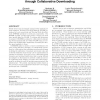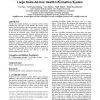MOBISYS
2007
ACM
15 years 4 days ago
2007
ACM
Most pages on the Web are designed for the desktop environment and render poorly on the small screens available on handheld devices. We introduce Reusable End-User Customization (...
MOBISYS
2007
ACM
15 years 4 days ago
2007
ACM
Smartphones have recently become increasingly popular because they provide "all-in-one" convenience by integrating traditional mobile phones with handheld computing devi...
MOBISYS
2007
ACM
15 years 4 days ago
2007
ACM
This paper presents MyExperience, a system for capturing both objective and subjective in situ data on mobile computing activities. MyExperience combines the following two techniq...
MOBISYS
2007
ACM
15 years 4 days ago
2007
ACM
The ease of deployment of battery-powered and mobile systems is pushing the network edge far from powered infrastructures. A primary challenge in building untethered systems is of...
MOBISYS
2007
ACM
15 years 4 days ago
2007
ACM
Mobile devices are increasingly equipped with multiple network interfaces: Wireless Local Area Network (WLAN) interfaces for local connectivity and Wireless Wide Area Network (WWA...
MOBISYS
2007
ACM
15 years 4 days ago
2007
ACM
MOBISYS
2007
ACM
15 years 4 days ago
2007
ACM
During mass casualty incidents, an enormous amount of data, including the vital signs of the patients, the location of the patients, and the location of the first responders must ...
MOBISYS
2007
ACM
15 years 4 days ago
2007
ACM
To allow for an efficient usage of a device in pervasive computing environments, reliable and yet convenient user access is an important requirement. The problem becomes more comp...
MOBISYS
2007
ACM
15 years 4 days ago
2007
ACM
An algorithm has been developed to automatically construct individual models of normal activity within a home using motion sensor data. Alerts can be generated when a period of in...
MOBISYS
2007
ACM
15 years 4 days ago
2007
ACM
We present rendezvous-based access control for access control in the pre-hospital environment. Rendezvous-based access control is a simple cryptographic access control method that...






